Page M
Study of Threes)
http://threesology.org
| 3-to-1 A | 3-to-1 B | 3-to-1 C | 3-to-1 D | 3-to-1 E | 3-to-1 F |
| 3-to-1 G | 3-to-1 H | 3-to-1 I | 3-to-1 J | 3-to-1 K | 3-to-1 L |
| 3-to-1 M | 3-to-1 N | 3-to-1 O | 3-to-1 P | 3-to-1 Q | 3-to-1 FF |
In a manner of speaking, anytime we give examples of ideas, we are indirectly discussing language. Vocal sounds (differing levels of air pressure) are but one type of physiological activity that we describe as expression, but it is not the only kind. There are others such as body language, the language of art, the language of silence, the language of music, mathematics, science, etc... With respect to the present discussion, the 3:1 ratio idea can be viewed as another form of the "three" expression viewed from another perspective of analyzing the notion of an underlying 1-2-3 developmental sequence.
The idea of a 1-2-3 maturational development sequence as well as the 3:1 ratio view may be representative of an underlying three-patterned mental template that is symbolically represented by linguistic patterns that may or may not be graphically displayed in a variety of contexts with different word labels being used as differing types of context-specific "jargon;" whether the context is a racial culture on a continent, colloquialism found in a state, during a particular era, in a small nation or large city, a normal, neurotic or eccentric household, profitable business, esoteric academic program, a gender grouping, sporting event, etc... And yet on a more fundamental level, this three-patterned "mental" template may in fact have sub-cultural, linguistic physiological, and genetic counterparts that were themselves initially designed by environmental influences, as is suggested by the recurring physiological, atomic, and biological patterns-of-three I have presented on other pages at this site.
However, if both patterns (as well as others) have an environmental influence, is it possible to identify the event(s)? In my attempts to answer such a question, it is necessary not only to account for patterns-of-three occurring in genetics such as the billions-of- years-old triplet codon system in DNA (even though others have focused on trying to understand what force(s) influenced the usage of a double helix instead of some other geometric form), but also circumstances of the 1-2-3 developmental sequence found in the example of the 1-2-3 Germ layers, and the pattern indicated by the many varieties of the 3:1 scheme that are listed.
In brief, these ideas may be symbolic renditions of the effects of the rate of the Earth's rotation in relation to the Sun (and moon) over billions of years of biological development. With respect to the 3:1 ratio, this same pattern is exhibited in the increased expansion of the three-"moment" (dawn-noon-dusk) Sun as it decays and its relationship to the Earth as its rotation rate continues to slow down. The expansion of the Sun is said to one day increase to the extent of engulfing the innermost three planets (Mercury, Venus, Earth), bringing its proximity closer to the planet Mars, perhaps making it a hospitable environment much in the same fashion as the Earth due to its position to the Sun. It is said that if the Earth were either a short distance closer or further from the Sun, this would create conditions unable to support life as we know it.
A few characteristics of the Earth/Sun/Moon relationship: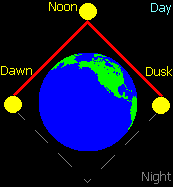
- The Earth was spinning faster in the past during life's beginnings, and it continues to slow down.
- The Sun is expanding as it decays and is thought to one day engulf the innermost three planets: (Mercury- Venus- Earth)
- The path of the Sun from dawn to noon to dusk forms an inverted "V" that some observers may prefer to label as a triangle or pyramid (or even a baseball diamond when both night and day geometric forms are viewed singularly/holistically).
- Three distinct "moments" of the Sun affect biological forms in distinct ways, (such as in a pattern-of-three, triangular or 3 to 1 ratio way) and may in fact affect certain molecular/atomic forms likewise.
- The distance between the Moon and Earth is increasing which alters tidal behavior and in-turn affects the rate of the Earth's rotation.
The expansion of the Sun, in concert with the slowing of the Earth's rotation as well as the retreat of the Moon away from the Earth will, in effect, play individual parts in the circumstances of the three aforementioned "moments" (dawn- noon- dusk) "fusing" together creating a 3 into/from/with 1 circumstance. This ever-progressing change that is occurring today, will no doubt continue to affect biological life. In a sense, just as the "solar triangle" appears to have impressed itself upon various life forms as indicated by the "triangles" formed by:
- Insects- termite mounds and antlion burrows.
- Birds- V-shaped flight formations during migration.
- Humans- pyramids, tepees, v-shaped engine blocks, (as well as simplistic orientations produced by clothing that enhances the regions of a V-shaped crotch, V-shaped cleavage, V-tapered torso).
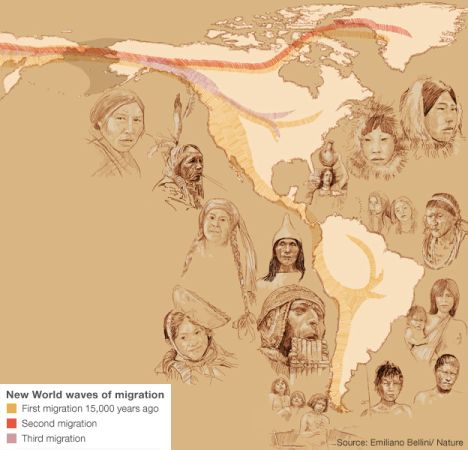
The fusing of the three solar moments is also a type of "branding iron" that is impressing its image in specific ways with respect to the characteristics of a given type of biological material, and perhaps even geophysical processes as well.
This 3:1 ratio influence can already be seen occurring in a variety of areas as the following short list illustrates. And it should be mentioned that with respect to a 1- 2- 3 maturational development sequence, this necessarily suggests that prior to the Earth habitability, Mercury and Venus may have been teeming with life when the early (faint young) Sun's presence was different to them. With life having begun on Mercury 1st, Venus 2nd, and not Earth 3rd, this is another pattern-of-three related to the other examples provided on various pages at this site and others.
3 patterned reference to the Black (bubonic) Plague in a child's lyrics:
- Ring-around-the-rosey (victims of bubonic plague had red spots on their skin).
- A pocket full of posies (this is a reference to herbal remedies thought to assist in preventing {or curing} someone from getting the illness), though I have also encountered that this refers to large pustules in the "pockets" of armpits and the groin region.
- Ashes, ashes, we all fall down (this refers to death and the burning of plague infested bodies as an attempt to prevent the disease from spreading).
(By separating the death {falling down} and the burning {ashes} of the last line, we could interpret this as a 3 to 1 ratio).
*** Teiresias's testimony: If the parts of love-pleasure be counted as ten, thrice three go to women, one only to men. (This can be viewed as a 3:1 ratio)
There is a British expression which could be look upon as a similarity to the foregoing: Playing 3 (two testicles and 1 penis) to 1 (Vagina). Because of all the sexual connotations being made by British society, more and more people are viewing it as a "pornofied" society in need of growing up because it can not get past its oral, anal and genital stages of development. It is further being considered that if it persists in its infantile orientations, serious consideration must be given to take an adequate course of action against it because it either refuses to mature, does not have the capacity to grow up, or represents a throw-back to an earlier hominid form that should have become extinct long ago.
3 to 1 ratio of ships used by Vasco da Gama as he sailed around the Southern Cape of Africa: 3 regular ships (São Gabriel~ São Rafael~ Bérnio) + 1 supply ship... whose captains were, respectively, Vasco Da Gama ~ Paulo da Gama ~ Nicolau Coelho + Gonçalo Numes
3 hots and a (one) cot: An expression sometimes used by those who stay in jail for a short time, or are subjected to circumstances that are not desirable but are tolerated for a short time and are rationalized as being endurable by providing them with 3 hot meals and a place to sleep.
Buy 3 tires get another one (1) free, is a common advertisement seen periodically in the U.S.A.
3 in 1 no Jive yo-yo was patented by Tom Kuhn.
3 to 1 ratio of Jungian personality types:
- 1 of 3. Sensation
- 2 of 3. Intuition
- 3 of 3. Feeling
- 1 of 1. Thinking
3 to 1 ratio of the four Vedas (primary texts of Hinduism that also influenced Buddhism, Jainism, Sikhism):
- 1 of 3. Sama Veda- collection of hymns used by the priests during the Soma sacrifice. Many of these duplicate in part or in whole hymns from the Rig Veda.
- 2 of 3. Yajur Veda- The Yajur Veda is a detailed manual of the Vedic sacrificial rites.
- 3 of 3. Atharva Veda- also contains material from the Rig Veda, but of interest are the numerous incantations and metaphysical texts, which this anthology (part of the Sacred Books of the East series) collects and categorizes. The Atharva Veda was written down much later than the rest of the Vedas, about 200 B.C.; it may have been composed about 1000 B.C.
- 1 of 1. The Rig Veda- the oldest of the four Vedas, was composed about 1500 B.C., and written down about 600 B.C.
3 to 1 ratio of Vedas: To an original complement of three Vedas (the Veda is sometimes referred to as the "threefold wisdom") was later added the Atharva Veda, and the "world of heaven" becomes a fourth world in the cosmological scheme. The enlargement of the tripartite classification system into a quadripartite one may very well have been stimulated by an analogous (or causative) historical expansion of Vedic society to include within it the non-Aryan indigenous inhabitants of South Asia. These natives the Indo-European invaders originally called dasas or dasyus, "slaves." Over time, as the invaders themselves became natives and as some of the original inhabitants were assimilated to some degree within Aryan society, the latter came to be known as "Shudras" and took over the bottom rung in the social order: a fourth social class was grafted onto the bottom of a social hierarchy previously consisting of three "twice-born" classes. In any event, the expansion of categorical systems from three to four is a recurring phenomenon in Indian intellectual history. In later Hindu texts, to the three purusarthas or "goals of human beings" (pleasure, power, and principle, kama, artha, and dharma) is added liberation (moksha) as a "transcendent fourth." The three ashramas or stages of life— student, householder, and forest dweller— are similarly expanded to include the renunciate's way of life (sannyasa).
H.O.B. note: The so-called "forth class" of Indic peoples was marginalized to some degree by Georges Dumezil in his Tripartite Ideology Of Indo-European peoples. He did not consider the existence of a so-called "forth" entity as the dawning manifestation of a 3 to 1 ratio phenomena. He relegated the so-called "forth" class into a non-class entity thereby maintaining his "Tripartite" theory. He did not assign the "forth" as being part of a 3 to 1 ratio which is very much a part of a larger "tripartite" perspective. He did not view his theory in terms of an environmentally influenced genetic predisposition that changes in accord with environmental/planetary "evolutions".
3 to 1 ratio of different haunting types:
- 1 of 3. Portal Hauntings- presently based on theory and conjecture as to existence of "portals".
- 2 of 3. Poltergeist Activity- traditionally thought of as "noisy ghost" but also is considered due to an emotionally disturbed individual unconsciously creating the "poltergeist" activity.
- 3 of 3. Residual Haunt- paranormal phenomena not necessarily related to ghosts.
- 1 of 1. Intelligent Haunt- most common form related to a sentient being, usually human.

3 to 1 finger pointing: There is sometimes encountered (in America) the expression about the pointing of a (one) finger at someone which results in having three fingers pointing at the pointer themselves. In this instance, the (non-"finger") thumb is not mentioned though its position is variable according to person and context. (It may be up, down, or intermediate.) As a point of research interest related to language, since many people do "talk" with hand expressions accompanying verbal remarks, a study of the index finger pointing phenomena might prove insightful to a largely taken-for-granted human behavior. For example, is pointing with the index finger a wide-spread characteristic, or is the thumb (etc.) used more-so in other cultures. If it is used predominantly in all cultures, is it due to some point of (transitional?) developmental cognition?
The expression: "If I've told you once I've told you a thousand times" could be viewed as a 1\3 (3 to 1) ratio by changing the word 'once' to the numerical value of 1 and the word 'thousand' to its numerical equivalent 1,000. Hence, in one sense, the 1 becomes a 1,000 by the addition of a comma and 3 zeros.
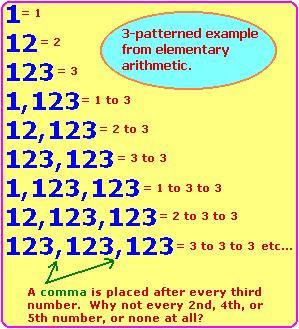
To give a simple example from the realm of mathematics for those of you who haven't looked at any of the other information I've placed on other pages, our counting sequence of ones~ tens~ hundreds~ thousands is a 3 to 1 (or 1 to 3) example when we acknowledge the usage of a comma after the hundreds from a right to left direction even though many people write left to right: 1,123. We place a comma after every third number value. Hence, a "three" part distinction can be seen. In the number 12,123 we may want to say we have a 2 to 3 ratio, but most people will overlook the fact that a higher valued number would repeat a usage of a "three" reference: 123,123; giving us a 3 to 3 ratio. Hence, we have an overall 3-patterned ratio formula which correlates to the 1~ 2~ 3 maturational development sequence discussed in previous pages: |
***As an aside note, when we compare the usage of a coma in numbers to distinguish the separation between the hundreds and the thousands place in a series of numbers:
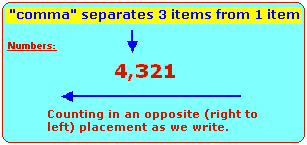
with the "and" used as a separator such as in the case of Adenosine, Cytosine, Guanine "and" Uracil (or Thymine):
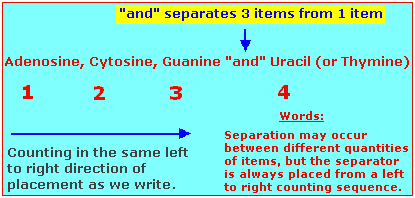
the comma in the number grouping is placed in a from right to left sequence, while the "and" in the word grouping is placed in a from left to right sequence. This may suggest that the "right to left" usage in numbers had an early middle eastern (Arabic?) influence, (since both modern numbers and this method of writing had much of their influential beginnings in this area), but the "left to right" placement of a series separator in words did not have.
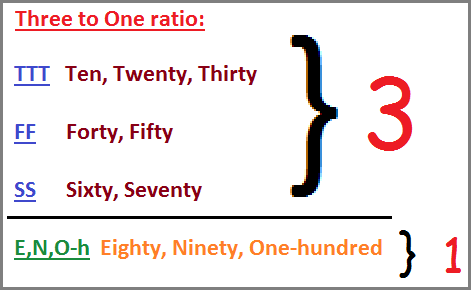
Page Created: Monday, June 24, 2013, 7:14 AM
Latest Posting: Monday, 11th August 2025...